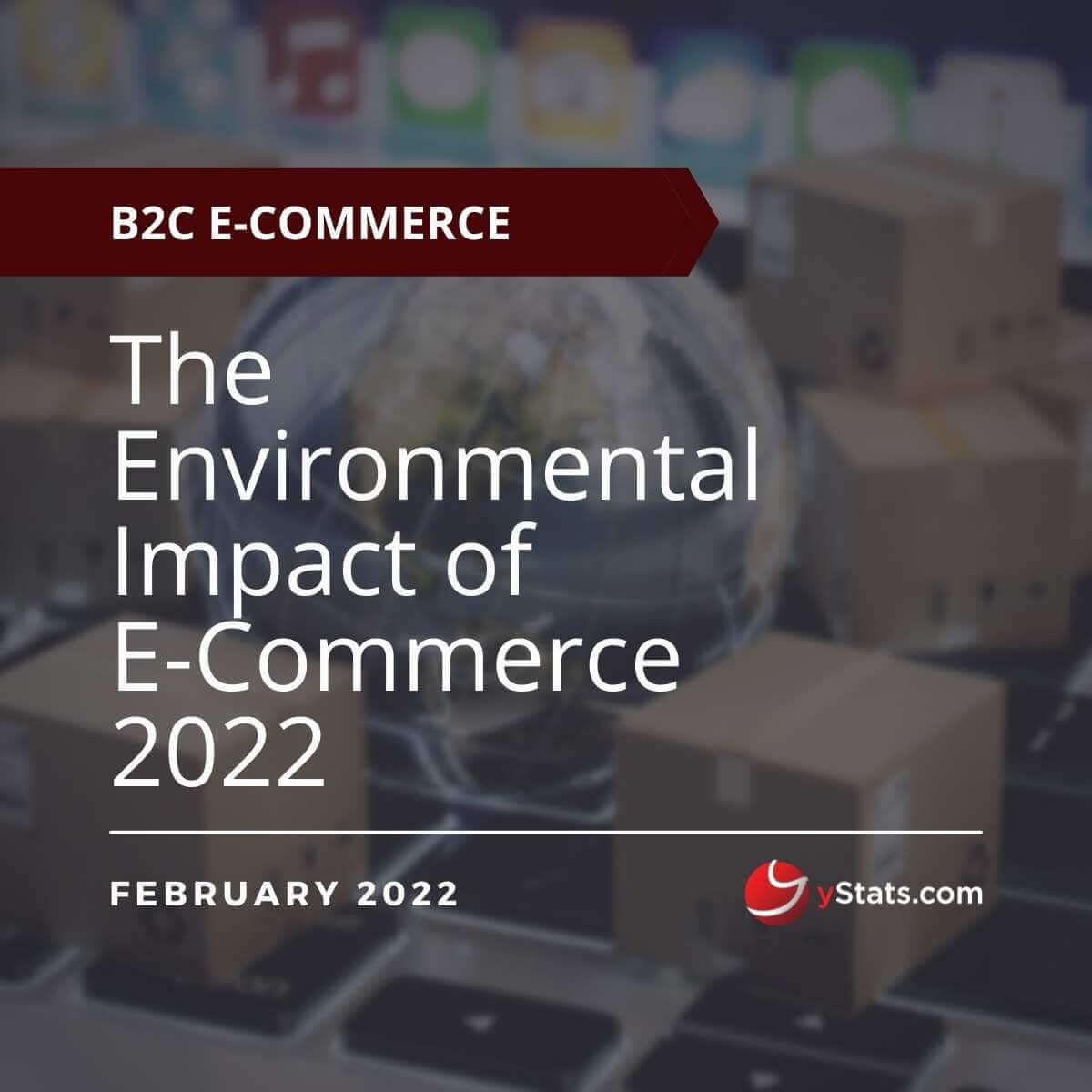Description
Countries Covered: Australia, China, Cyprus, Germany, India, United Kingdom, United States
Pages: 60
Publication Date: 08/02/2022
Questions Covered in the report:
- What was E-Commerce’s share in air cargo worldwide in 2021?
- Under which circumstances are online shoppers willing to change their behavior to have a lower environmental impact?
- Which market trends are important in the development of measures to lower the environmental impact of E-Commerce worldwide?
- What are the biggest emission sources for online and in-store purchases?
- What are consumer attitudes towards buying eco-friendly and sustainable products?
Key Findings:
Carbon Footprint of E-Commerce depends on multiple factors
According to research cited in the yStats.com report, online shopping can have a lower carbon footprint as compared to in-store shopping. However, how much lower the impact depends on multiple factors, including whether customers drive to retail stores by car or other means of transportation and whether they return items purchased online, and if so, to which location and by which means of transportation. Among the biggest emission sources for online shopping the source lists last-mile delivery and energy consumption for IT, whereas for traditional shopping, these include energy consumption of building and consumer’s trip to physical store.
European online shoppers changed their behavior during the pandemic leading to less returns
A survey from December 2020 cited in the yStats.com report unveiled the average return rate of 10 to 20% for all product categories across European geographies studied, including France, Germany, Italy, Spain, and the United Kingdom. The high returns rate of E-Commerce are highly criticized as they cause environmental impacts mainly due to double shipping, extra packaging, and returned articles not always being eligible for resale. On the positive note, according to the sources cited in the report, the returns rate of online shoppers in Germany was reduced due to a structural change in customers’ behavior during the COVID-19 pandemic. Customers switched to buying more consciously and taking into account their current needs leading to less spontaneous purchases, hence, fewer returns.
Online shoppers care about the environmental impact of E-Commerce and are willing to take action
As a rule of thumb, the quicker the delivery, the higher the harmful emissions related to an online purchase. A recent survey of cross-border online shoppers showed that close to three out of ten of them would receive their package later to lower environmental impact. Another survey found that over 40% of European respondents were willing to pay a premium for ecological transportation of online purchases. Moreover, more than seven in ten global surveyed travelers think that travel companies should offer more sustainable choices.
E-Commerce companies implement solutions to lower the environmental impact of online purchases
Many E-Commerce companies, including Amazon, Alibaba.com, Zalando, and OTTO are implementing measures to lower their environmental impact. These range from investment in electric vehicles, renewable energy, introducing reusable mailing bags, optimizing packaging material use, eliminating single-use plastic materials from packaging, among others. Also, many companies, as well as start-ups, are emerging on the E-Commerce scene with fixes to environmental issues. Some of them focus on reverse logistics, others dedicate themselves to last-mile delivery, returns and packaging challenges. For example, Fision, which is specialized in 3D models for virtual fitting, was acquired by Zalando to tackle the returns problem of fashion items. Big post office and parcel companies are also joining the movement. For example, Deutsche Post DHL Group announced to invest in a climate-neutral logistics solution, with a focus on e-mobility and alternative fuel for aviation.
1. Management Summary
2. Overview & Introduction
- B2C E-Commerce Sales Value, in USD trillion, and Share, in % of Total Retail Sales, 2019 – 2025f
- Top 10 Countries by Retail E-Commerce Sales Value, incl. China, Germany, UK, USA, in USD billion, 2020 & 2021e
- Share of Online Grocery Shopping in E-Commerce Sales, in %, 2019 & 2020
- Parcel Volumes, in billions, 2014-2020 & 2026f
- Share of Traffic Expressed in Vehicle Kilometers Generated In Urban Areas, by E-Commerce and Physical Shops, in %, December 2020
- Top 4 Countries Purchased From in the Latest Cross-Border Online Purchase, in % of Cross-Border Online Shoppers, 2019 & 2020
- Breakdown of Time Needed for Cross-Border Delivery, in % of Cross-Border Online Shoppers, October 2020
- E-Commerce’s Impact on the Environment – Overview, December 2021
- Comparison of carbon footprint of a national online purchase and average in-store purchase for the same non-food item with consumers driving to store, in Gram of CO2-equivalent per item, December 2020
- Comparison of carbon footprint of a national online purchase and average in-store purchase for the same non-food item with average transportation patterns, in Gram of CO2-equivalent per item, December 2020
- Comparison of carbon footprint of a national online purchase and average in-store store purchase for the same non-food item with average transportation patterns, in Gram of CO2-equivalent per item, December 2020
3. Consumer Attitudes Towards Sustainability
- Attitudes Towards Shopping Online, incl. Buying from Retailers Who Offer Efficient Delivery or Collection, Buying Eco-Friendly and Sustainable Products, in % of Respondents, September 2021
- Respondents Reviewing Their Individual Purpose due to the COVID-19 Pandemic, in %, and Being Attracted To Environmentally-friendly Brands, in % of Respondents Who Agree or Disagree that the Pandemic Made them Review Their Life Purpose, in %, February 2021
- Consumers Considering Fairly or Very Important Retailers Taking Into Account the Environmental Impact and Sustainability Of Their Operations, in % of Respondents, by Age Group, and by Gender, 2021
- Attitude Towards Online Stores Taking Into Account The Environmental Impact of Their Actions, in % of Adult Respondents, June 2021
- Top Nine Fashion Purchasing Choices, incl. “Value for Money” and “Sustainable Production”, in % of Respondents, 2021
- Consumers Who Consider Buying Second-Hand Clothes Important, in % of Respondents Consumers Who Purchase Second-Hand Clothes Regularly, in % of Respondents, 2021
- Attitude Towards Online Shopping Being More Sustainable Than Brick-and-Mortar Retail, in % of Respondents, April 2021
- Attitude Towards Using The Same Packaging For Returns, in % of Respondents, April 2021
4. Product Returns and the Effect on the Environment
- Volume of Packages Returned to Online Shops per UPS, in Millions per Week, Week 1 January 2020 & Week 1 January 2021f
- Value of Returns, in USD billion, Holiday Season 2019 & Holiday Season 2020
- Number of Returned Parcels in E-Commerce, in Million, and Returns Rate, in %, 2019 & 2020e
- Breakdown of Reasons for Returning an Item, in % Online Shoppers, 2020
- Share of Returns, by Australia, China, Cyprus, India and the USA, in % of Cross-Border Online Shoppers, October 2020
5. Special Sales and Their Environmental Impact
- Sustainable Trends in the Singles Day in China, November 2021
- Alibaba’s Gross Merchandise Value Through Singles Day Sales, in USD billion and in Year-on-Year Change, in %, 2020 & 2021
- Retail E-Commerce Sales from November 1st to 29th 2021, in USD billion and in Year-on-Year Change, in %, 2020 & 2021
6. Delivery and Online Shoppers’ Attitudes Towards Environmentally-Friendly Options
- Share of E-Commerce in Air Cargo, in %, 2021 & 2022f
- Consumers Attitudes To Large Retailers Sustainable Delivery Options, in % of Respondents, by Age Group, and Average, January 2021
- Willingness to Pay Extra for Ecological Transportation of Online Purchases, in % of Respondents Aged 18-24, June 2021
- Breakdown of Attitudes Towards Carbon-Neutral Delivery, in % of Cross-Border Online Shoppers, October 2020
7. Sustainable Payments
- Payment and Sustainability – Players Overview, December 2021
8. Sustainable Travel
- Carbon Dioxide Emissions From Jet Kerosene Combustion, in Tons, 2018-2020
- Attitude Towards Travelling More Sustainably In The Future As A Result of The Pandemic, in % of Adult Respondents, March 2021
- Attitudes Towards Sustainable Travel, in % of Adult Respondents, March 2021
9. Players and Current Developments
- E-Commerce and Sustainability – Players and Current Developments, December 2021






